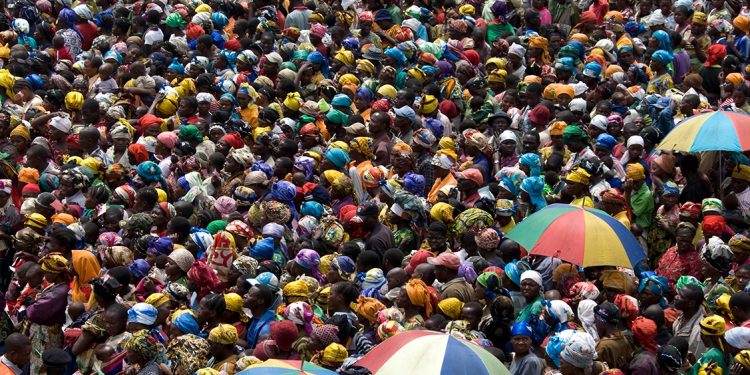United Nations: India’s population is projected to peak in the early 2060s at about 1.7 billion and then decline by 12 per cent, but the country will remain the world’s most populous throughout the century, the United Nations has said.
The World Population Prospects 2024 report, released here Thursday, said that the world’s population is expected to continue growing over the coming 50-60 years, reaching a peak of around 10.3 billion people in the mid-2080s, up from 8.2 billion in 2024. After peaking, the global population is projected to start declining gradually, falling to 10.2 billion people by the end of the century.
India, which surpassed China as the world’s most populous nation last year, will continue to hold that position through 2100.
“The population of India, which is expected to remain the world’s largest throughout the century, will likely decline by 12 per cent after reaching its peak in the early 2060s at about 1.7 billion,” the UN report published by the United Nations Department of Economic and Social Affairs (DESA), Population Division said.
According to the report, India’s population in 2024 is projected at 1.45 billion and this will peak to 1.69 billion in 2054. After this, India’s population is projected to decline to 1.5 billion by the end of the century in 2100, but the country will still remain the most populous nation on Earth.
Responding to a question by PTI on population projections for India, Senior Population Affairs Officer, Population Division, UN DESA Clare Menozzi said at a press conference that “India is currently the largest country in the world in terms of population, and it is projected to stay so throughout the century. The population is currently estimated at 1.45 billion, and it’s supposed to increase further” to 1.69 billion.
“It’s supposed to peak around the 2060s in size and then it starts to slightly decline. So by the end of the century, India is projected to be around 1.5 billion, but still the largest country in the world by a large margin.”
The report said that China’s population, currently 1.41 billion in 2024, will fall to 1.21 billion in 2054 and further decline to 633 million by 2100.
“It is anticipated that China, the country currently with the world’s second-largest population, will likely experience the largest absolute population loss between 2024 and 2054 (204 million),” followed by Japan (21 million) and Russia (10 million). “Longer-range population projections are more uncertain” for China, it said.
“However, due to its large size and sustained low level of fertility, China is also likely to record the largest population decline of any country through the end of the century (786 million people). By 2100, China is projected to have lost more than a half of its current population and to have returned to a population size comparable to that recorded in the late 1950s (50 per cent probability).”
Responding to a question on the significantly low population projection for China, Director of the Population Division at UN DESA John Wilmoth said that “it really relates to the level of fertility that’s observed currently in China. The current number is right around one birth per woman on average over a lifetime.”
“Given that you need 2.1 births to maintain the current population without migration, if fertility levels remain at such a low level, even if they come up slightly, any fertility level if it’s below two, or especially below 1.8 or below 1.5, you’re really getting into low levels of fertility and it produces a long run decline that’s quite significant. And that’s true for China. It’s true for some other countries in this analysis,” Wilmoth said.
Currently, nearly one-fifth of all countries and areas, including China, Italy, the Republic of Korea and Spain, are experiencing what is sometimes referred to as “ultra-low” fertility, with fewer than 1.4 live births per woman over a lifetime.
The report added that the global fertility rate currently stands at 2.25 live births per woman, down from 3.31 births in 1990.
“More than half of all countries and areas globally have fertility below the replacement level of 2.1 live births per woman. This is the level required for a population to maintain a constant size in the long run (without migration), with each generation being followed by another of roughly equal size,” it said.
Pakistan is projected to overtake the US as the third-largest country in the world, with a population of 389 million in 2054.
Currently, the US is the third largest country in the world with a population of 345 million and in 2054, it will be the fourth largest with 384 million people. Pakistan will remain the third largest country in the world, with a population of 511 million people in 2100.
The report said that the estimated likelihood that the world’s population will peak within the current century is very high, with a probability of 80 per cent, a major change in UN projections from a decade ago, when this probability was around 30 per cent. The size of the world’s population in 2100 is now expected to be 6 per cent smaller – or about 700 million people fewer – than anticipated a decade ago.
In about 126 countries and areas, the population is likely to continue growing through 2054, potentially reaching a peak later in the century or beyond 2100. This group includes several of the world’s most populous countries: India, Indonesia, Nigeria, Pakistan and the United States of America.
In 2023, the global number of deaths among children under age 5 fell below 5 million for the first time in recent history. However, 95 per cent of such deaths took place in the 126 countries with populations that are still growing, including the Democratic Republic of the Congo, India, Nigeria and Pakistan.
The report added that globally, life expectancy at birth reached 73.3 years in 2024, an increase of 8.4 years since 1995. Further reductions in mortality are projected to result in an average longevity of around 77.4 years globally in 2054.
Since 2022, life expectancy has returned to levels observed before the emergence of the coronavirus disease in nearly all countries and areas. At the height of the COVID-19 pandemic during 2020 and 2021, global life expectancy at birth fell to 70.9 years, down from 72.6 in 2019.
The report said that by 2080, persons aged 65 or older will outnumber children under 18. “By the late 2070s, the number of persons at ages 65 years and higher globally is projected to reach 2.2 billion, surpassing the number of children (under age 18). By the mid-2030s, it is projected that there will be 265 million persons aged 80 years or older, more than the number of infants (1 year of age or less),” it said.
PTI






































